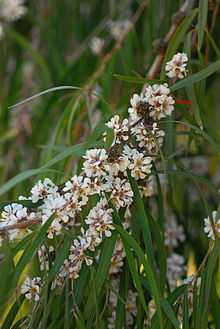Agonis flexuosa
| Agonis flexuosa | |
|---|---|
 | |
| Flowers of A. flexuosa | |
| Scientific classification | |
| Kingdom: | Plantae |
| (unranked): | Angiosperms |
| (unranked): | Eudicots |
| (unranked): | Rosids |
| Order: | Myrtales |
| Family: | Myrtaceae |
| Genus: | Agonis |
| Species: | A. flexuosa |
| Binomial name | |
| Agonis flexuosa (Willd.) Sweet | |
Agonis flexuosa is a species of tree that grows in the south west of Western Australia. It is easily the most common of the Agonis species, and is one of the most recognisable trees of Western Australia, being commonly grown in parks and on road verges in Perth.
The species is commonly known as Western Australian peppermint, Swan River peppermint or peppermint, and willow myrtle for its weeping habit.
Description
A. flexuosa occurs mainly as a small and robust tree, usually less than 10 metres tall, although it may grow to 15 metres. It has fibrous, brown bark, and long, narrow, dull green leaves, with tightly clustered inflorescences of small, white flowers in the axes. It grows in a weeping habit, and looks remarkably like the weeping willow from a distance. Leaves are narrow and reach a length of 150mm. It is most readily identified by the powerful odour of peppermint emitted when the leaves are crushed or torn.
It flowers between August and December. The fruit is a hard capsule, 3 – 4 mm across, with three valves containing many small seeds.[1]
Taxonomy
The genus name Agonis comes from the Greek agon, "a cluster", referring to the arrangement of the fruits. The species name flexuosa is Latin for "full of bends", referring to the zig-zag course of the stem, which changes direction at each leaf node. It was originally placed in the Leptospermum genus by Sprengel in 1819, but Schauer placed it in Agonis in 1844.
The two recognised varieties are Agonis flexuosa var. flexuosa and Agonis flexuosa var. latifolia. The cultivar Agonis flexuosa 'Nana' is a dwarf form that is commonly seen in Perth as a hedge.
Distribution and habitat
Agonis flexuosa occurs in a subcoastal strip from just north of Perth, southward through the Swan Coastal Plain, then along the coast to outlying records east of Bremer Bay (34°23'S).

The habitat includes limestone heath, stable dunes, and sandy soils; usually inland from the coastline, and it also grows as an under-story plant in Tuart forest.[1]
Cultivation
The tree is used in mass plantings, such as street trees, and has been introduced to Rottnest and Garden Islands near its native region. Agonis flexuosa is an attractive garden or specimen tree in temperate climates. However, care must be exercised in selecting it for small areas, as in a yard setting. Quick growing, the tree produces a large amount of detritus and its trunk sometimes becomes large and disproportionate to the rest of the tree.
References
| Wikispecies has information related to: Agonis flexuosa |
- "Agonis flexuosa". FloraBase. Department of Environment and Conservation, Government of Western Australia.
- Boland, D. J. et al. (1984). Forest Trees of Australia (Fourth edition revised and enlarged). Collingwood, Victoria, Australia: CSIRO Publishing. ISBN 0-643-05423-5.
- Blackall, W. E. and Grieve, B. J. (1980). How to Know Western Australian Wildflowers, Part 3A (2nd ed. ed.). Nedlands, Western Australia: University of Western Australia Press. ISBN 0-85564-160-6.
- Powell, Robert (1990). Leaf and Branch: Trees and Tall Shrubs of Perth. Perth, Western Australia: Department of Conservation and Land Management. ISBN 0-7309-3916-2.